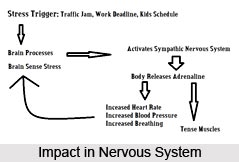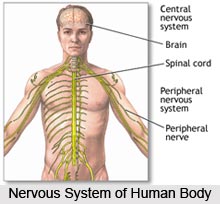 The nervous system controls the functions of different organs and the activities of the entire organism as a whole. It works through sensation, integration and response, to maintain homeostasis. This neural base is responsible for moment-to-moment adjustment, immediate coordination and communication with the internal and external environment from where the stimuli are constantly received. The system responds quickly to the sudden change in internal as well as external environment. As far as the inner environment is concerned, an individual rarely become aware of it. For instance, one is not conscious of his/her breathing. In order to turn an individual`s attention inward, Hatha Yoga advices Pranadharana technique, i.e. watching the flow of breath. Hence yoga and its practices contribute a lot in properly maintaining the nervous system.
The nervous system controls the functions of different organs and the activities of the entire organism as a whole. It works through sensation, integration and response, to maintain homeostasis. This neural base is responsible for moment-to-moment adjustment, immediate coordination and communication with the internal and external environment from where the stimuli are constantly received. The system responds quickly to the sudden change in internal as well as external environment. As far as the inner environment is concerned, an individual rarely become aware of it. For instance, one is not conscious of his/her breathing. In order to turn an individual`s attention inward, Hatha Yoga advices Pranadharana technique, i.e. watching the flow of breath. Hence yoga and its practices contribute a lot in properly maintaining the nervous system.
The nervous system controls the functions of different organs and the activities of the entire organism as a whole. It works through sensation, integration and response, to maintain homeostasis. This neural base is responsible for moment-to-moment adjustment, immediate coordination and communication with the internal and external environment from where the stimuli are constantly received. The system responds quickly to the sudden change in internal as well as external environment. It links various organs and systems, coordinates their functions and maintains the integrity of the organism. Any change in the function of one organ or system leads to changes in the functions of other organs or systems. For instance, during vigorous muscular work a large quantity of carbon dioxide is produced which is brought to the lungs to be thrown out of the body. This requires faster blood circulation and rapid respiration. Such necessity is informed to the brain centers, which in turn accelerate the cardio-respiratory function. The blood supply to the working muscles increases and at the same time the heat production and loss of heat also increase. All these rapid but well coordinated changes are brought about by the nervous system.
According to the functions, the nervous system may be divided into two principal divisions: The Central Nervous System (CNS) and The Autonomic Nervous System (ANS)
The ANS is further divided into two parts, (i) Sympathetic nervous system and (ii) Parasympathetic Nervous System. If strong muscular efforts are slackened and the interference of the cortex is reduced during the yoga practice, the effect of emotions and sympathetic nervous system is also reduced. When tension on the neuromuscular system is reduced, the psycho-physiological relaxation is established. Naturally then the load on the cardio-respiratory system is minimum.
The Central Nervous System, on the other hand, includes the brain, spinal cord, 12 pairs of cranial nerves, arising from the brain and 31 pairs of spinal nerves. All the organs and tissues are connected with the brain by numerous branches of these nerves. These nerves and their branches constitute the Peripheral Nervous System (PNS). A healthy central nervous system (brain and spine), healthy glands and healthy internal organs are the secret of vitality and rejuvenation that enable one to remain level headed in stressful situations. The power and activeness of the body depends on the power and health of the brain. Yoga asanas, Pranayama and Meditation contribute a lot for maintaining a healthy, active and powerful brain.  There are a series of Yoga asanas that very helpful to pump in blood to the brain and the spinal cord in extra quantity and add energy for all round development of the body and the mind.
There are a series of Yoga asanas that very helpful to pump in blood to the brain and the spinal cord in extra quantity and add energy for all round development of the body and the mind.
Naukasana in a supine position is another effective asana in nourishing the nervous system. The asana should be maintained for a considerable time to reap the best benefits. Raising the body from both sides should look like the shape of a boat. Gently inhaling, one should sit up on the hips with arms up in the front. This Yoga asana should be maintained for a considerable time as well.
A healthy spine obviously plays an important role in vitality and rejuvenation. In fact, the spine is more critical to our well being than the brain, since the brain is fairly protected by the cranium or skull bone. Where the spinal nerves leave the spine and pass through the intervertebral foramina is a very vulnerable area. If a vertebra is slightly out of place, it may cause the nerve to be `pinched` in the intervertebral foramina. The spinal nerves do not have protection against mechanical insults as the brain does.
Yoga practitioners are aware of the importance of the spine and the tendency for slight spinal misalignments to occur. They also knew that if the spine is kept flexible by yoga asanas there would be much less chances for spinal misalignments. Some of the asanas will even correct some minor misalignments. If nothing is done to retain the spine`s flexibility as the person gets older, his spine will deteriorate further and the spinal nerves will be increasingly impinged upon.
The main objective of the yogic practices, such as, yoga asanas, pranayamas, bandhas and mudra is to strengthen the nervous system so as to counter-balance the spiritual power of kundalini, when awakened.



